Early learning and childcare at age five: comparing two cohorts
A report on early learning and childcare use and provision in Scotland, comparing Growing Up in Scotland data from 2008-09 and 2014.
4 Child Outcomes at Age 5
4.1. Introduction
This chapter focuses on children's adjustment to primary school and their social and cognitive development at the start of primary school. A previous GUS report looked at adjustment to primary school among children in BC1 (Bradshaw et al., 2012). Previous analyses of GUS data have also considered BC1 children's social and cognitive development at age 3 and explored how this had changed by age 5 (e.g. Bradshaw et al., 2014). The analysis presented below adds to these existing findings by considering, for the first time, outcomes for children in BC2 at the time they were aged 5. Furthermore, through comparing outcomes between children in BC1 and BC2, it examines whether there has been any improvement in outcomes for children at the start of primary school between 2009/10 and 2015. Finally, the chapter looks at differences in outcomes between children according to socio-economic characteristics and location, including household income, parental education, area deprivation and urban/rural location.
4.2. Key findings
- In both 2015 and 2009/10, the vast majority of children were reported by their parent or carer to have adjusted well to primary school.
- Compared with children the same age in 2009/10, 5 year old children in 2015 were a little more likely to complain about school and to be reluctant to go to school, and a little less likely to look forward to going to school. Nonetheless, overall levels of adjustment to primary school were very similar.
- Levels of hyperactivity and pro-social behaviour improved between the cohorts. For example, the proportion of children exhibiting higher than average levels of hyperactivity fell from 21% in 2009/10 to 18% in 2015. Meanwhile, the proportion of children displaying below average levels of pro-social behaviour fell from 17% to 14%.
- Looking at all children, there was no change in average problem solving ability at age 5 between the cohorts. In contrast, the analysis showed a slight decrease in average vocabulary ability for children this age.
- Looking at children according to socio-economic and area characteristics, in both 2009/10 and 2015, children living in less advantaged circumstances were more likely to be reported as having 'below average' levels of adjustment to primary school, poorer levels of social development and lower levels of cognitive ability than their more advantaged peers.
- Between 2009/10 and 2015, on the measure of pro-social behaviour there were signs of a slight widening of the gap between children whose parents had no formal qualifications and children whose parents had a degree. In contrast, on the measure of vocabulary ability, there were signs of a slight narrowing of the gap between children in the poorest and the wealthiest families.
4.3. Adjustment to primary school
Starting primary school is an important milestone in a child's life, representing one of the most significant changes to their daily lives since birth. There is a growing body of literature demonstrating differences in how children accommodate this change. While some cope easily and make the transition to school smoothly, others find it more stressful (Fabian and Dunlop, 2006). This can impact negatively on children's early school experiences, and can also have a longer-term impact on their educational outcomes.
As outlined in section 2.4.1, two composite measures of adjustment to primary school were derived based on parents' responses to six questions. This section draws on both the composite and individual measures.
4.3.1. Adjustment to primary school among 5 year old children in 2015
The majority of children in BC2 were reported by their parent or carer as having adjusted well to primary school. As Figure 4-1 illustrates, almost all children in BC2 said good things about school and looked forward to going to school at least once a week (97% on each measure). Just under a third of children complained about school (31%) or were reluctant to go (28%) at least once a week.
Figure 4‑1 Child's adjustment to primary school (parent report), BC2
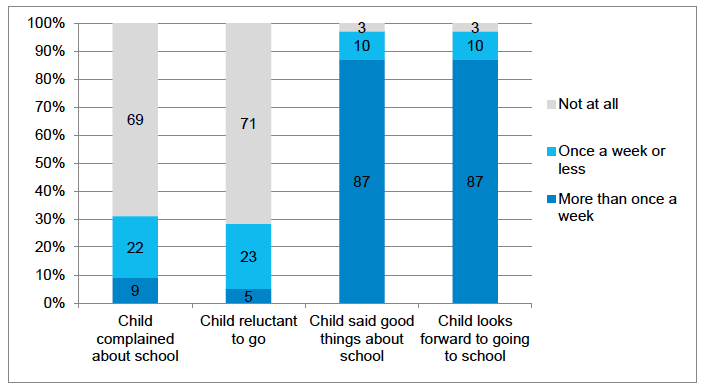
Base: BC2 cases where the cohort child had started primary school at time of age 5 interview and where relevant questions were answered. Base sizes (unweighted/weighted): Complained about school = 1680/1549, Reluctant to go = 1682/1551, Said good things = 1679/1547, Looks forward to going = 1678/1547.
Further, as shown in Figure 4-2, the vast majority of parents agreed that, overall, their child had adjusted well to primary school (91%). A relatively small minority of parents (18%) agreed that their child was finding it hard to sit still or listen in class.
Figure 4‑2 Child's adjustment to primary school (parent report), BC2
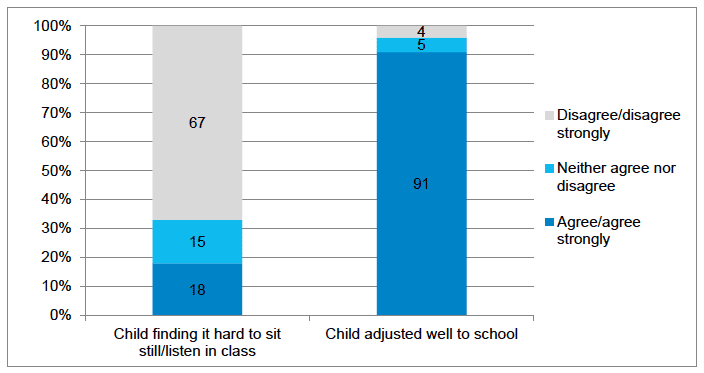
Base: BC2 cases where the cohort child had started primary school at time of age 5 interview and where relevant questions were answered. Base sizes (unweighted/weighted): Child finding it hard to sit still/listen = 1647/1517, Child adjusted well to school = 1548/1681.
This rather positive picture is also evident when looking at the composite measures of adjustment. For example, as shown in Figure 4-3 just 2% of children were classified as having poor levels of adjustment.
4.3.2. Comparing adjustment to primary school across the cohorts
At an overall level, the analysis showed no differences in the parent-reported level of adjustment to primary school across the cohorts. Figure 4-3 shows the proportion of children in each cohort who had 'excellent', 'good/average' or 'poor' perceived levels of adjustment. It shows that adjustment to primary school was similar across the cohorts - the apparent difference in the proportion with excellent adjustment was not statistically significant.
Figure 4‑3 Proportion of children with 'poor', 'good/average' and 'excellent' adjustment to primary school (parent report), by cohort
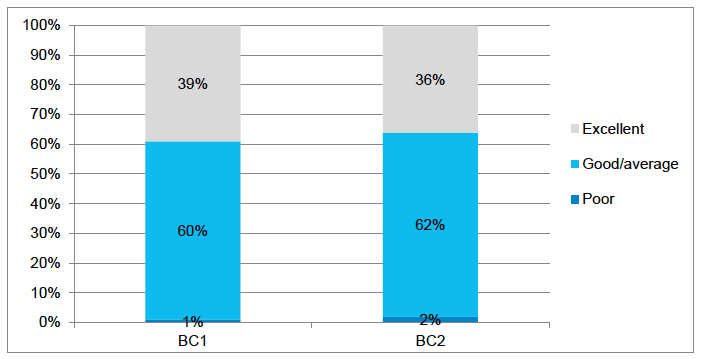
Base: Cases where the cohort child had started primary school at time of age 5 interview and where relevant questions were answered. BC1 Base sizes: Unweighted = 1227, Weighted = 1239, BC2 Base sizes: Unweighted = 1681, Weighted = 1550.
There were, however, some small differences on some of the individual measures. [40] Firstly, compared with children in BC1, children in BC2 were more likely to complain about school: 31% of children in BC2 complained about school at least once a week compared with just 21% of children in BC1. Children in BC2 were also slightly more likely than children in BC1 to be reluctant to go to school: 29% of children in BC2 were reluctant to go to school at least once a week compared with 23% in BC1. Finally, children in BC2 were slightly less likely to look forward to going to school: 87% of children in BC2 looked forward to going school 'more than once a week' compared with 91% in BC1.
4.3.3. Variations by socio-economic and area characteristics
Previous GUS analysis of BC1 data showed that levels of parent-reported adjustment to primary school tended to be lower for children in more socio-economically disadvantaged circumstances (Bradshaw et al., 2012). This section explores whether such patterns were also evident in BC2. More specifically, it considers whether parent-reported adjustment to primary school among children in BC2 varied according to household income, parental education, level of area deprivation, and urban/rural location, and whether this differed to patterns found among children in BC1.
Figure 4-4 shows that, in both cohorts, children living in lower income households were more likely than children in higher income households to be reported as having below average levels of adjustment to primary school. For example, in BC2, 43% of children in the lowest household quintile had below average perceived levels of adjustment compared with 31% in the highest quintile. There was no statistically significant difference in the relationship between household income and parent-reported levels of adjustment to primary school between the cohorts.
Figure 4‑4 Proportion of children with 'below average' levels of adjustment to primary school (parent report), by equivalised household income (quintiles) and by cohort
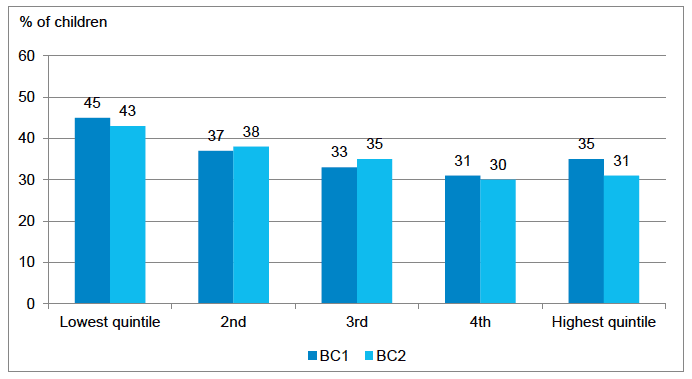
Base: Cases where the cohort child had started primary school at time of age 5 interview and where relevant questions were answered. Base sizes (unweighted/weighted): BC1 = 1230/1242, BC2 = 1684/1552.
Children living in households with lower levels of education were also more likely than those whose parents had higher levels of education to have below average reported levels of adjustment. For example, as shown in Figure 4-5, among BC2 children whose parents had lower standard grades or below or had no formal qualifications, 46% had below average levels of perceived adjustment compared with 33% of children whose parents were educated to degree level. There was no statistically significant difference in the relationship between parental education and adjustment to primary school across the cohorts. Nonetheless, there were some signs that difference between the lowest education group and the highest education group had narrowed between the two cohorts. For example, in BC2, children whose parents had lower standard grades or below or no formal qualifications were less likely to have below average adjustment to primary school than their counterparts in BC1: 46% in BC2 versus 53% in BC1.
Figure 4‑5 Proportion of children with 'below average' levels of adjustment to primary school (parent report), by highest household level of education and by cohort
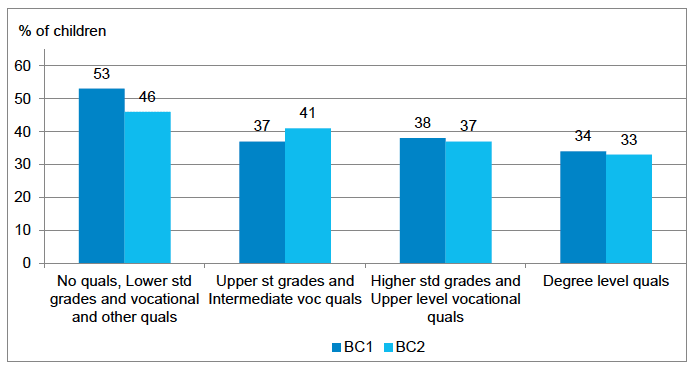
Base: Cases where the cohort child had started primary school at time of age 5 interview and where relevant questions were answered. Base sizes (unweighted/weighted): BC1 = 1230/1242, BC2 = 1684/1552.
The analysis showed no differences in parent-reported levels of adjustment to primary school according to either the level of area deprivation or urban/rural location in either of the cohorts.
4.4. Social, emotional and behavioural development at age 5
As outlined in section 2.4.2, in GUS, children's social, emotional and behavioural development is measured through the use of the SDQ (Goodman, 1997). Previous analysis of BC1 data has shown that children living in less advantaged circumstances tend to have higher levels of socio-emotional and behavioural difficulties than their more advantaged peers (e.g. Bradshaw and Tipping, 2010). This section looks at the social, emotional and behavioural development of children in BC2 when they were nearing their fifth birthday, in 2015. It further examines whether there is evidence of any changes in the social development of 5 year olds since 2009/10, when children in BC1 were the same age. Finally, it considers whether socio-economic and area characteristics continue to be associated with children's social development at this age - including whether there is any evidence of a widening or a narrowing of the gap between the most and least advantaged children.
Further details about the measures used in the analysis can be found in section 2.4.2. Note that due to variations in the number of 'don't know' responses across individual questions, base sizes in the charts vary slightly between the measures.
4.4.1. Social, emotional and behavioural development among 5 year old children in 2015
As shown in Table 4‑1, at the age of 5 the vast majority of children in BC2 did not present any social, emotional or behavioural difficulties as measured on the SDQ. For example, on the total difficulties scale - which combines scores from the emotional symptoms, conduct problems, hyperactivity and peer problems items - 90% of children had scores in the 'close to average' range. Just 5% had scores classed as slightly raised, while 2% had scores classed as high, and 3% had scores classed as very high.
Across the individual difficulty scales - emotional symptoms, conduct problems, hyperactivity and peer problems - between 82% and 95% of children returned scores within the 'close to average' range. Between 3% and 8% of children had slightly raised scores, while between 1% and 8% had high scores and between 1% and 7% had very high scores. On the pro-social scale, 86% of children had 'close to average' scores, 8% had slightly lowered scores, 4% had low scores and 2% had very low scores. These proportions broadly match what would be expected for SDQ scores taken from any community population in Britain. [41]
As the figure shows, the most common form of difficulties reported for 5 year old children in 2015 was hyperactivity: almost one in five children had scores classified as above average on this measure (18%). The least prevalent type of difficulties reported for 5 year olds in 2015 was emotional symptoms where just 5% of children had a score outside the average range.
Table 4‑1 Strengths and Difficulties Questionnaire subscales, BC2 (row %)
| SDQ scores | Bases | ||||||
|---|---|---|---|---|---|---|---|
| Total difficulties scales | Close to average | Slightly raised (Slightly lowered)* |
High (Low)* |
Very high (Very low)* |
Unwtd | Wtd | |
| Total difficulties | % | 90 | 5 | 2 | 3 | 4317 | 4300 |
| Emotional symptoms | % | 95 | 3 | 1 | 1 | 4335 | 4321 |
| Conduct problems | % | 88 | 7 | 3 | 2 | 4335 | 4320 |
| Hyperactivity | % | 82 | 7 | 4 | 7 | 4334 | 4320 |
| Peer problems | % | 85 | 8 | 4 | 3 | 4328 | 4312 |
| Pro-social score | % | 86 | 8 | 4 | 2 | 4331 | 4316 |
Base: All cases where information was provided for relevant questions.
*Descriptions in brackets refer to the pro-social subscale which runs in the opposite direction of the difficulties scales (i.e. a lower pro-social score indicates a less positive outcome).
4.4.2. Comparing social, emotional and behavioural development across the cohorts
When comparing 5 year old children in 2015 with children who were the same age in 2009/10, the analysis showed some small but statistically significant improvements in social, emotional and behavioural development.
As shown in Figure 4-6, the mean total difficulties score dropped from 7.9 in BC1 to 7.6 in BC2. This indicates a slightly lower level of overall difficulties among 5 year old children in 2015 compared with children the same age six years previously. However, the analysis showed no differences in the proportion of children with 'close to average' total difficulty scores (90% in both cohorts). This suggests that any improvements between the cohorts were very small. Similarly, despite a slight difference in mean score, the level of conduct problems was very similar across the cohorts. [42]
More notable changes were visible in relation to hyperactivity and pro-social behaviour. On these measures, differences between the cohorts were evident both when looking at the mean scores and when looking at the proportion of children with scores outwith the 'close to average' range.
For hyperactivity, the mean score dropped from 3.8 in BC1 to 3.5 in BC2 while the proportion of children with scores outwith the 'close to average' classification dropped from 21% to 18%. This suggests that 5 year old children in 2015 were less likely than children who were the same age six years previously to display behaviours associated with hyperactivity.
For pro-social behaviour, the mean score rose from 8.2 in BC1 to 8.4 in BC2, while the proportion of children with scores outside the 'close to average' range dropped from 17% to 13%. This suggests that, compared with children who were aged 5 in 2009/10, 5 year olds in 2015 were more likely to exhibit pro-social behaviours such as being considerate of other people's feelings, sharing readily with other children and being helpful if someone is hurt.
Figure 4‑6 Mean Strengths and Difficulties scores, by cohort
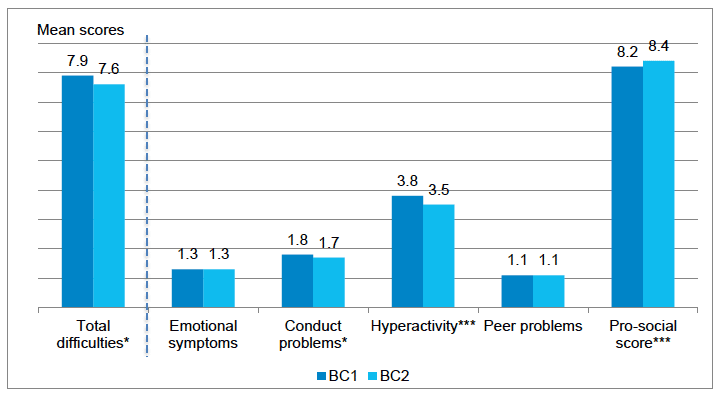
Bases: All cases where information was provided for relevant questions. BC1 Base sizes (unweighted/weighted): Emotional symptoms = 3786/3779, Conduct problems = 3803/3797, Hyperactivity = 3793/3785, Peer problems = 3801/3795, Pro-social score = 3802/3796.
BC2 Base sizes: Emotional symptoms = 4335/4321, Conduct problems = 4335/4320, Hyperactivity = 4334/4320, Peer problems = 4328/4312, Pro-social score = 4331/4316, Total difficulties = 4317/4300
*** significant difference between the cohorts at p<.001 level; * significant difference between the cohorts at p<.05 level.
Note: The pro-social scale runs in the opposite direction of the difficulties scales (i.e. a higher pro-social score indicates a more positive outcome, while a higher difficulties score indicates a more negative outcome).
4.4.3. Variations by socio-economic and area characteristics
As noted above, previous analyses of GUS data found that, among children who entered primary school in 2007/08 or 2008/09, those in less advantaged circumstances were reported to have higher levels of social, emotional and behavioural difficulties and lower levels of pro-social behaviour (Bradshaw and Tipping, 2010). This section examines whether such patterns were also apparent among BC2 children when they were the same age, including whether there are any signs of a widening or a narrowing of the gap between the most and the least advantaged children according to household income, parental education, and level of area deprivation. Associations with urban/rural location are also explored.
Similar to patterns found previously, among children in BC2 household income was strongly associated with all six measures of social, emotional and behavioural development. [43] Compared with their peers in higher income households, children in lower income households had higher mean scores - that is, higher levels of difficulties - on all five measures of difficulties (i.e. total difficulties, emotional symptoms, conduct problems, hyperactivity and peer problems). Conversely, on the pro-social behaviour measure children in lower income families had lower mean scores than those in higher income families - indicating that, on average, children in more disadvantaged circumstances displayed less pro-social behaviours than their peers in more advantaged circumstances. The analysis showed no indications of any change in the relationship between household income and children's social development between the cohorts.
Parents' level of education also remained associated with all six measures of children's social development at age 5: in 2015, as in 2009/10, mean difficulties scores fell as parents' level of education increased, with the reverse pattern evident for pro-social behaviour. [44] Thus, children whose parent or parents had higher levels of education continued to display fewer symptoms of social, emotional and behavioural difficulties than children whose parents had lower levels of education. Indeed, there were indications that differences between children according to their parents' level of education had increased slightly in relation to pro-social behaviour. [45] On this measure, across the different levels of education, children in BC2 had higher mean scores than their BC1 peers, indicating higher levels of pro-social behaviour. The slight widening of the gap on this measure seems to be driven by a combination of higher levels of improvement among children whose parents were qualified to degree than all other groups, and no improvement among children whose parents had no qualifications or lower standard grades (see Figure 4-7).
Figure 4‑7 Pro-social mean score, by highest household level of education and by cohort
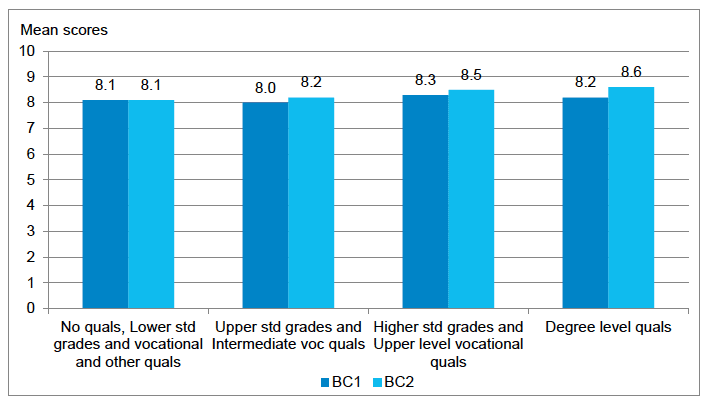
Base: All cases where information was provided for relevant questions. Base size (unweighted/weighted): BC1 = 3802/3796, BC2 = 4331/4316.
The level of area deprivation was also associated with all six measures of social, emotional and behavioural development, with better outcomes reported for children in less deprived areas than for their peers in more deprived areas. [46] For example, on the measure of pro-social behaviour, the pro-social mean score for children in the least deprived quintile was 8.6 while it was 8.2 for those in the most deprived quintile. There were no statistically significant changes in the relationship between area deprivation and any of the difficulties measured across the cohorts. [47]
Finally, in both cohorts, whether a child lived in an urban or rural location was - perhaps surprisingly - associated with their reported level of social, emotional and behavioural difficulties but not with pro-social behaviour. For example, on the total difficulties scale children living in urban locations had higher mean scores (7.8) than children in towns (7.3) and children in rural areas (7.1). Similar patterns were evident for the other measures of difficulties, suggesting that, on average, children in urban areas have more socio-emotional and behavioural difficulties than children in towns and rural areas. [48] This is likely to be explained, at least in part, by differences in socio-economic circumstances, with children in urban areas more likely to be living in disadvantaged circumstances (see e.g. Pateman, 2011).
4.5. Cognitive development at age 5 in 2015 and 2009/10
Previous longitudinal research has established that early cognitive ability influences later life outcomes. For example, analysis of the 1970 Birth Cohort Study showed that assessments of ability at 22 and 42 months predicted educational qualifications at age 26 (Feinstein, 2003). Other research has shown that poor cognitive ability in the early years can have a negative impact on a range of other outcomes, including employment, health and social development (Duncan and Brooks-Gunn, 1997; Essen and Wedge, 1978; Rutter and Madge, 1976). Using cohort studies such as GUS to measure cognitive ability can therefore help to build a better understanding of children's cognitive development and to identify stages at which interventions might be effective in improving later outcomes. As detailed in section 2.4.3, cognitive assessments were carried out with children in both cohorts as part of the age 5 interview, when most children were aged 58 months. Two different assessments were carried out: naming vocabulary (a measure of expressive vocabulary) and picture similarities (a measure of problem solving abilities).
Figure 4‑8 shows the mean vocabulary and problem solving scores for children in BC1 and BC2 when they were aged just under 5 (2009/10 for children in BC1; 2015 for children in BC2). A higher score indicates a higher level of ability. [49]
Figure 4‑8 Mean cognitive ability t-scores at age 5, by cohort
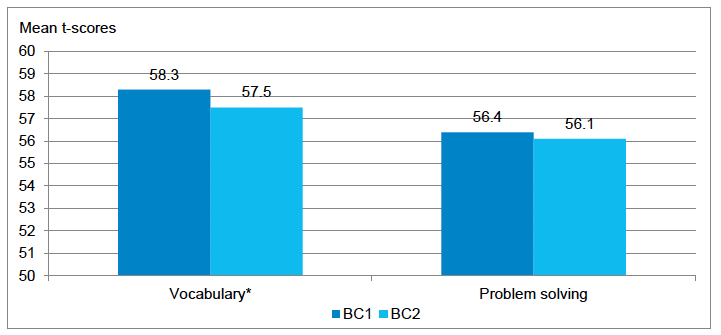
Base: All children who completed assessments. BC1 base sizes (unweighted/weighted): Vocabulary = 3723/3706, Problem solving = 3721/3703, BC2 base sizes (unweighted/weighted): Vocabulary = 4326/4310, Problem solving = 4314/4300.
* significant difference between cohorts at p<.05 level.
Figure 4-8 shows that when comparing mean cognitive ability t-scores across the two cohorts, children in BC2 had slightly lower vocabulary scores at age 5 compared with children in BC1. This suggests that 5 year olds in 2015 had slightly poorer vocabulary than 5 year olds six years earlier. This finding contrasts that from a similar analysis using data collected when the children were aged 3 which showed that, on average, 3 year old children born in 2004/05 had higher vocabulary test scores than 3 year olds born in 2010/11 (Bradshaw et al., 2015). It therefore appears that between age 3 and age 5, children in BC2 progressed slightly less rapidly than children in BC1. However, it is worth noting that the difference between the cohorts at age 5 was smaller than that found at age 3. Taken together, the findings suggest that the improvements in vocabulary between the cohorts found at age 3 had, at best, been cancelled out by age 5.
Whilst the average problem solving score for children in BC2 was also very slightly lower than in BC1, this difference was not statistically significant. A similar pattern for problem solving ability was found when comparing BC1 and BC2 at age 3 (Bradshaw et al., 2015).
4.5.1. Variations in cognitive ability scores by socio-economic and area characteristics
Previous analysis using BC1 data found that children living in more socio-economically disadvantaged circumstances tended to have lower cognitive ability than children in more advantaged circumstances (Bradshaw et al., 2014). This section explores whether such patterns were also evident among children in BC2. In particular, it examines whether cognitive ability varied according to household income, parental education and level of area deprivation, and whether this was different to the patterns found in analyses of BC1 data. Differences by urban/rural location are also explored.
In BC2, cognitive ability varied significantly according to socio-economic characteristics and location. In terms of household income, as income increased, cognitive ability also increased for each assessment. For example, for vocabulary, children living in households with an annual income in the top quintile had a mean t-score 7.7 points higher than those living in households with an annual income in the lowest quintile. Similarly for problem solving, children in the highest income quintile had a mean t-score 4.8 points higher than those in the lowest income quintile.
Parental education and area deprivation followed a similar pattern with children living in more advantaged circumstances having higher average scores on both vocabulary and problem solving than children in less advantaged circumstances. [50] There were also differences in cognitive ability among children in BC2 by urban/rural location. For the vocabulary assessment, children living in rural areas had the highest score (59.9), followed by towns (58.1) and urban areas (56.8). For the problem solving assessment, children living in towns had the highest score (57.6), followed by rural (57.4) and urban areas (55.4). [51]
Differences in average cognitive ability between children with different socio-economic characteristics were broadly similar across BC1 and BC2. In both cohorts, children living in less advantaged circumstances had lower average scores than those in more advantaged circumstances. There was only one difference between the two cohorts which was statistically significant. As shown in Figure 4-9, the gap in vocabulary ability between children in the lowest and highest income households narrowed between the cohorts. In BC1, the difference in mean t-scores between children in the highest and the lowest income quintiles was 8.8, while in BC2 the difference had reduced to 7.7. This is explained by a small increase in vocabulary scores among children in the lowest income group alongside a decrease in vocabulary scores among children in the higher income groups.
Figure 4‑9 Mean vocabulary t-scores, by equivalised household income and by cohort
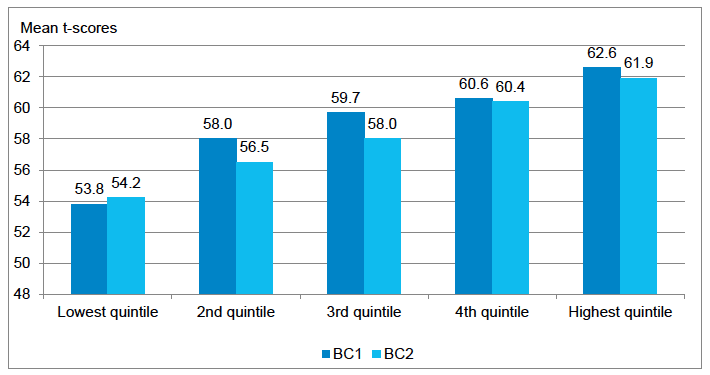
Base: All children who completed assessments. Base sizes (unweighted/weighted): BC1 = 3723/3706, BC2 = 4326/4310.
Contact
There is a problem
Thanks for your feedback